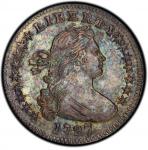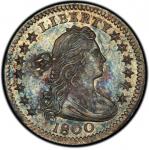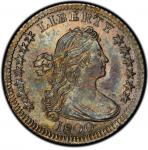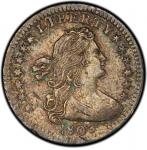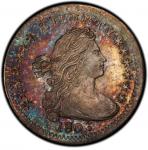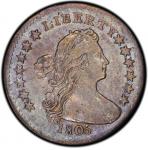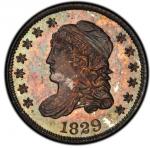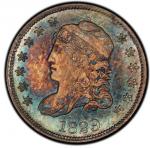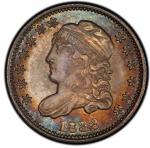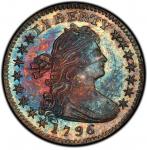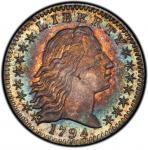"And do mutually agree with each other to form ourselves into a free and independent state, by the name of the State of Tennessee.” — The Constitution of the State of Tennessee, 1796This obverse die inspired a realization on the part of the Philadelphia Mints engravers: we cannot keep adding stars every time a new state joins the Union. The crowded obverse is rich with opalescent pale green gleam, frosty and colorful with hints of blue and gold. The reverse is even brighter, with reflective pastel blue at center yielding to more subtle gray, violet, and cobalt tones near the rims. A short scratch extends only from the denticle to star 7, and real effort is required to focus light and glass enough to find a hairline in the fields. The strike is excellent, despite the significant clashing, with the eagles breast nearly full feathered. The individual denticles are well defined around almost the entire circumference of both sides, just a bit soft in the southeast quadrant of the obverse. A thin die crack divides star 7 from star 8. The clashing that befell this obverse die during its first marriage (LM-2) had been lapped or ground away by the time this coin was struck in its second marriage, and is visible only in dulled form in the right obverse field, a slightly raised crest behind the hair ribbons, and in a few places around the central reverse. The barest suggestions of a few parallel adjustment lines cross Libertys hair above her shoulder.This is the finest example known from these dies. Two of its closest competitors are pieces we have offered in the last dozen years: the 2004 Oliver Jung specimen, graded PCGS MS-65, and the Eliasberg coin currently graded NGC MS-66. Neither is so aesthetically pleasing nor as elegantly toned as this one, and neither is so well struck. Both the Eliasberg and Jung coins lack central reverse detail, with neither coin showing any breast feathers on the eagle. A different example from the collection of Oliver Jung, also graded MS-66 (PCGS), stands tied atop the PCGS Population Report with this one. The cataloger (JK) prefers the strike, color, and eye appeal of this example. The Jung MS-66 sold for $141,000 in August 2014.The 1797 16 Star half dime is an important historical type, representing the furthest the first U.S. Mint pushed the short-lived plan to place one star on the obverse of our silver and gold coins for each state in the Union. The 16th star marked the 1796 entry of Tennessee, and made the obverse of silver and gold coins appear entirely too crowded. While 13 stars would become de rigueur in later years across all denominations, this policy was clearly in flux in 1797, as the year saw half dimes produced with 15 stars, 16 stars, and 13 stars.
“The best returns are from the choicest specimens; a coin in absolute perfection is the pride of the advanced numismatist.” — John Walter Scott, 1913The idea of perfection among pre-modern American coins is a chimera. Its an asymptote, a limit which cannot be reached no matter how close a coin comes. No 18th or 19th century American coin has ever graded Mint State-70. Viewed with the naked eye, low magnification, or high magnification, there is not a single noteworthy flaw. Studying this coin, fixating on it, training our eye to find any caliber of imperfection, we found two: a single short hairline right of the final S in STATES, and the merest contact mark on a denticle just right of the final date digit. Thats it. In every other aspect, this coin is a miracle of survival. The luster careens around both obverse and reverse as languidly as it did the moment it fell from the dies. The eye appeal is fantastic, with golden peripheries blending melodiously into the sort of aquamarine, cobalt, and violet tones that make collectors swoon. The strike is excellent, with every strand of hair defined and the eagle looking like it was hand carved from stone. The area outside the denticles, near the dies edge and free of design, shows the merest vestiges of adjustment lines above UNITED, where a small natural rim burr is also present. A thin die crack is present below I of UNITED to the point of the shield where the azure and gules meet. A thinner die crack is noted under M of AMERICA to the nearby scroll, but unlike later states of this reverse (see LM-3), these two die cracks do not yet connect. The dies are unclashed.In our sale of the Norweb Collection, we described this coin as “perfectly centered and with broad rims. Reflective surfaces. Beautifully toned, with rosy centers surrounded by iridescent blue borders. Sharply struck, with every strand of Libertys hair separated and full feather detail visible on the reverse... An outstanding specimen, surely among the finest known of the date and variety. A coin worthy of the most advanced cabinet.” It brought $70,400 in that 1987 sale, nearly as much as the $77,000 Norweb 1894-S dime brought later that same evening. It has not been available for public sale since.
Liberty With a K.A thoroughly lustrous gem, richly toned in light olive with hints of peach and gold. The outsized cartwheel spins around both sides, while frost surrounds the devices. The strike is ideal, a bit soft outside the denticles as expected, but crystalline elsewhere. A few individual hairlines cross the bust, but no contact points or other flaws are seen. Strike doubling is visible on the lower parts of the date digits. The reverse, used previously on LM-1 and LM-2, shows a single fine crack across it, from below I of UNITED to the left upright of M in AMERICA. Light clash marks are visible, most notably at the right end of the star cluster. The eye appeal is all that the grade promises, original and fresh, beautiful to behold.A spectacular specimen of this popular variety, distinctive for the broken R punch in LIBERTY that gives it its appellation. Better struck than the superb Norweb coin that sold for $37,400 in October 1987, this piece is the finest example certified by PCGS. That services CoinFacts estimates the grade of the Norweb coin at MS-65, though they have not officially graded it since its sale. For the last two decades, this coin has resided in two of the most significant high grade collections of U.S. coins ever formed: the Foxfire Collection of Claude E. Davis, M.D. and the D. Brent Pogue Collection.
“I have never seen an Uncirculated one, nor do I believe one exists in the numismatic world.” — Harold P. Newlin, 1883The D. Brent Pogue Collection 1801 LM-2 half dime is the Holmes-Pittman-Price specimen, long counted among the few Mint State survivors of this elusive date, but challenging to grade considering its typically soft strike. Earlier graded MS-61 by NGC, your cataloger (JK) described this coin in 2004 as “Pleasing blue-gray toning with golden highlights around the periphery. Highly lustrous and very attractive, despite weakly struck centers that leave some design details ill defined. Well defined at peripheries, some very light hairlines detectable under a glass, no noteworthy contact marks. Die clashing noted in obverse fields, some die chatter present. A superb specimen of the date, one whose rarity is well known to specialists in the series but is overshadowed among non-specialists by the 1802; the mintage of 27,760 pieces does not fairly state just how scarce this issue is. Most examples are well worn, including the Eliasberg specimen. As the Pittman catalog noted, this piece is probably Condition Census for the date (i.e. top six specimens known), outshone by a MS-67 piece certified by NGC that brought $112,500 in 1998.” More recently, that finest known piece has resold for $164,500 and is now certified MS-66+ by PCGS.The presently-offered Pogue Collection coin was described in the famed 1960 Holmes sale as: “An impossible coin to find above Fine. This specimen is Nearly Uncirculated with full mint luster. It is weakly struck like most but certainly one of the nicest to come up for sale in the last five years.” While the portraits profile is soft, several stars retain their centers, and the unbroken cartwheel luster suggests the accuracy of a Mint State grade. The single die clash has not yet been lapped away, but the die state is advanced enough to show crumbling at the rim at 3:00 on the obverse. The reverse does not yet show crumbling at 9:00. Desirable for its attractive color, historic provenance, and strong originality, this remains one of the finest examples available of this die marriage.
“One of the classic rarities of U.S. numismatics.” — Russell J. Logan and John W. McCloskeyBeyond its status as the key date among all issues of the denomination, the 1802 half dime is a classic, the object of many collectors quests, and an epic destination unto itself. Indeed, this was the very final piece of the puzzle for the D. Brent Pogue Collection, the single early American date that had eluded their grasp in a grade that met their lofty demand for quality.Perhaps the third finest extant, only clearly exceeded by the Newlin-Garrett coin, this coin far surpasses a typical 1802 half dime, nearly every example of which is damaged or in low grade. Only light wear is seen, and fine toning of violet-gray dominates both sides, with rich gold tracing the devices. Some light hairlines are noted under the toning, and a glass finds some minor evidence of handling. A short horizontal scratch is present low on Libertys jaw line, some shallow marks in the lower left obverse field, similarly shallow old worn scratches among the star and cloud cluster and above the arrows on the reverse. The strike is typical, a bit blunted on Libertys bust, soft on the lowest curls, somewhat ill-defined at the left side of the star cluster. The die state is also typical, with an unusual die crack above Libertys highest wave of hair to below B of LIBERTY and a rim break above E of UNITED. The grade and eye appeal, however, are entirely atypical. That this is not a gem Mint State coin like so many of the other Pogue half dimes should not be a distraction, as no such 1802 half dime, nor anything close to it, exists. A long list could be composed of legendary collections that have never included any 1802 half dime, a list that would start with F.C.C. Boyd, whose “Worlds Greatest Collection” sale suffered from very few omissions from the era of the first U.S. Mint, beyond an 1802 half dime. David J. Davis has theorized that Boyd owned a counterfeit that was withdrawn before the 1945 auction, a sensible speculation.The 1802 half dime has been the most famous issue in the entire half dime series since interest in it began shortly after the denominations production run ended. Harold P. Newlin wrote his monograph on the series in 1883, just 10 years after the Mint Act of 1873 ended the half dimes heyday. Rich with false modesty, he wrote in his preface that “the writer contributes the following article, entirely conscious that it possesses little or no merit, in the hope that it may awaken an interest in the subject, and that at no far distant day a numismatist, eminently better qualified for the work, will give to the fraternity the benefit of his researches.” That challenge remained until Dr. Daniel W. Valentine picked up the gauntlet in 1931 and published an effort that would remain standard until 1998, a text that used this very coin to illustrate the series most famous rarity. Newlin drew significant attention to the 1802 half dime, focusing on it in his 1883 monograph and attempting a census of known specimens (he found 16 of them).As noted in the “History of Bust Half Dime Collection,” in the front matter of the Logan-McCloskey book, “nearly one-third of [Newlins] publication is devoted to this single date,” and its fame only grew from there. Augustus Heaton, one-time president of the American Numismatic Association, included it in his poem about rare silver coins called “The Silver Barons.” B. Max Mehl devoted an entire page to the 1802 half dime in his 1947 W.W. Neil sale, the sort of treatment he usually reserved for 1804 dollars, furthering the comparison by noting “the 1802 half-dime has always been considered as one of our very rarest of all U.S. silver coins, nearly in the same category as the 1804 dollar.”Through all this remarkable rise in fame, this specimen appears to have avoided much in the way of public notice. Its provenance begins with its publication in the Daniel W. Valentine work, the standard for more than a half century, with its earlier owners not known. Valentine could have acquired it from Wayte Raymonds 10th sale in 1926, which offered an example called “Fine”; no other specimen in any grade is known to have sold at auction between 1922 and the publication of Valentines monograph in 1931. The Pogue coin transacted privately for most of the 20th century until being discovered in a notable Virginia collection in 1999, trading through several dealer intermediaries, and finally emerging for its first auction appearance in 2006.This remains one of the very finest known examples of this legendary rarity. Only the Newlin-Garrett coin is a known finer example, the two AU-55 listings on the PCGS Population Report both representing that specimen.
“The present coin is not only unequalled but unapproached.” — Walter Breen, 1968An extraordinary specimen of this rare variety, ever so close to Mint State. A good deal of luster persists on both sides, especially notable on the reverse. The toning offers excellent originality, with an appealing medium gray base decorated with egg speckles of pastel blue, yellow-gold, and deeper gray, with hints of rose at the central reverse. Some light marks are seen, including a short scuff in the lower left obverse field near star 2 and a dull mark hidden in Libertys side tresses. Softness of strike outside the denticles at 12:00 and 6:00 presents some planchet texture that never received enough pressure to be obliterated. The sharpness is excellent, with just minor softness at the bust tip and the concomitant area near cloud 5 and star 3 amidst the reverse cluster. The die state is early, with the always present die injury beneath B of LIBERTY but none of the other evolving die defects noted by Logan and McCloskey. Both the Valentine plate coin (later in the 1960 Milton A. Holmes sale) and the Logan-McCloskey plate coin show the break at the bust truncation; this does not. Full of eye appeal and, like most everything else in the D. Brent Pogue Collection, essentially impossible to improve upon.Called the “Finest Known of the Ex. Rare 1803 Small Date” by Walter Breen in 1968, Breen described this piece in Lester Merkins sale of September of that year as “Perfect die. (Borderline R-7.) Borderline Unc., slightly finer than the 1801. Pastel rainbow tone and mint luster, exceptional sharpness especially on curls, only one star above eagles head weak, everything else bold save part of drapery. A variety of small bag marks. Almost unobtainable above Good; the Eliasberg, Valentine, and WGC examples are the only other fine ones known. The present coin is not only unequalled but unapproached. Naked-eye type coin, unaccountably ignored in standard references.”The last offering of this coin in April 2009 is the only auction appearance PCGS CoinFacts cites of a coin graded better than AU-50, extending back over a decade. The best PCGS-certified example to sell in recent memory was offered in the July 2009 Stacks sale, graded EF-45, and the 1995-2000 “Significant Auction Records” database by John Dannreuther and Jeff Garrett likewise shows nothing better than an EF. The only comparable offering we can pinpoint is the same one cited by the Logan-McCloskey book, their plate coin, an AU-55 offered in Bowers and Merenas sale of the Chris Schenkel Collection in November 1990. The Bareford coin was called Uncirculated in 1981 but has not been seen since.Despite its status as a major variety in an early series, with just 35 or so specimens extant, the 1803 Small Date remains underappreciated, particularly so in this kind of grade. This is an issue that deserves to be known outside the community of half dime specialists.
“Commonest 1803, but still a scarce coin, and rare in Mint State.” — Walter Breen, 1958Called the “most common” die marriage of 1803, it is anything but common in this lofty grade. Only the Eliasberg coin, the sole PCGS MS-65+, stands out as a clearly finer example of the die marriage. The frosty luster and exceptional color lend this coin world-class eye appeal, with the violet and blue of the left obverse dawning into gold-tinted brilliance at right. The reverse is mostly a rich golden tone, with the familiar blues and violets of deeply toned silver near the right periphery. The strike is excellent, with a full complement of clouds, good drapery, fine feathers, and just two stars and a few lower curls showing evidence of weakness. Despite some forgettable and ancient hairlines that are faintly visible under scrutiny, and a small area of tiny contact points in front of the profile, this coin boasts the overall look of a coin finer than the grade assigned. Evidence of a light single clash is visible behind the eagles head.Extraordinarily well struck for the issue, better than either the Norweb or Milton A. Holmes coins in that regard. While we have not seen all the coins certified at higher grades, it is hard to imagine they are as detailed or as attractive as this one. Struck the year the United States negotiated the Louisiana Purchase, few other silver coins of this date, large or small, have survived in such splendid condition.
“In this choice condition, I consider it of equal rarity with the 1802.” — B. Max MehlThe only known die marriage of this date, the final entry into the Draped Bust half dime series. While scarce in all grades, this date is particularly rare in high states of preservation, and PCGS has never certified an example as Mint State. Good luster persists around the obverse periphery and in areas of the reverse. Both surfaces display an overall shade of lavender with highlights of bright silver gray. The strike is typical for the issue, or perhaps a bit better, with softness at the bust tip and the corresponding area below OF. Scattered faint hairlines and a few light marks are seen, including a small contact point outside of star 9 and another above E of UNITED. The vestiges of parallel adjustment lines are mostly struck out in the vicinity of stars 2 through 4.Just a single Mint State example, never seen by PCGS, is thought to exist, the coin sold in Lester Merkins sale of September 1968. Walter Breen described that piece as “finest known, superior to Parmelee:829 (long believed best) or to the Eliasberg and Atwater coins.” NGC has certified only one Mint State coin, a remarkable MS-65, which is likely the Merkin coin and may be the coin now held by a New England owner. The Eliasberg coin was graded AU-50 when offered in 1996. B. Max Mehl called the Atwater specimen Extremely Fine, noting, “In this choice condition, I consider it of equal rarity with the 1802.” Parmelees, while not plated, must have been nice: it sold for $37, $6 more than his 1804 eagle.
“One of the few of the new emission struck on the fourth day of July A.D. 1829.” — Adam EckfeldtA singularly historical issue among U.S. coins, struck to mark the occasion of the cornerstone laying of the second Philadelphia Mint on July 4, 1829. Proof examples of the 1829 half dime are more numerous than others of the design type because of this special minting, but few, perhaps none, resemble this one in overall quality. The toning is thick, dense, and luxurious, a blanket of colorful splendor presenting deep olive green peripheries that mellow toward the center while embracing rose, amber, and blue. A few small areas avoided toning, perhaps protected by foreign matter, including the chin, an area right of the date, and a smaller area behind the shoulder curl. The strike is complete and the fields are fully mirrored and watery in texture. Every star has a center, the raised vertically oriented die preparation lines are visible on the obverse, and the rims are rigid and crisp.The eye appeal, as if this needs to be mentioned, is nothing short of wondrous. 1829 half dimes in Proof are very special coins, with at least some of them coined in connection with the laying of the cornerstone at the technologically advanced second Mint facility at Chestnut and Juniper streets in Philadelphia on July 4, 1829. The first U.S. Mint at this point suffered, according to Mint Director Samuel Moore, from “privations and impediments by which the Mint is now embarrassed,” and attempts to enlarge the first Mint were now scrapped in favor of opening a brand new building. In recognition of the history of the Mint to that point, a number of pieces were laid in the cornerstone that would commemorate both the past and the present, with an eye on the technology of the future. The days ceremonies were recounted in the July 18, 1829 edition of the Niles Weekly Register after initial reporting from the Philadelphia Gazette:“Mint of the United States. The foundation stone of the edifice about to be erected ... was laid on the morning of the fourth of July at 6:00, in the presence of the officers of the Mint, and a number of distinguished citizens. Within the stone was deposited a package, securely enveloped, containing the newspapers of the day, a copy of the Declaration of Independence, of the Constitution of the United States, and of the farewell address of George Washington; also specimens of the national coins, including one of the very few executed in the year 1792, and a half dime coined on the morning of the fourth, being the first of a new emission of that coin, of which denomination none have been issued since 1805.”Three varieties of 1829 half dimes are known in Proof, but it appears this set of dies, LM-2, was the set of dies in use on July 4, 1829. The Proof 1829 half dime that was given to Mint Director Robert Patterson from Chief Coiner Adam Eckfeldt was discovered in 2012, still in the family of Mint Director Robert Patterson. It was accompanied by a letter of transmission from Adam Eckfeldt identifying the coin as “one of the few of the new emission by him struck on the fourth day of July A.D. 1829, American Republic 53rd, one of which was deposited on the same day in the foundation stone of the new building now erecting in Philada for the accommodation of the operations of the Mint establishment.”The only piece retained in the Mint Cabinet, begun in 1838 by Adam Eckfeldt and including a number of pieces saved by him from his term as chief coiner, was also a specimen of the LM-2 die variety.There are three die varieties of 1829 half dimes known in Proof finish. As stated, it is likely that only this die pair was in production on July 4th. As the very finest example of a Proof from these dies, this coin is doubly desirable, to both the historian and the quality connoisseur.
“A change was made in the device, Mr. Reich, the former assistant engraver, having prepared the new dies.” — Harold P. Newlin, 1883Although the above citation is interesting, Reich, in fact, left the Mint in 1817 and had died years before the 1829 half dime dies were made using a motif he had created in 1807.This coin is perhaps the finest known example struck for circulation, a miracle survivor from a population of over a million coins that saw instant and plentiful circulation almost a quarter century after the half dime denomination was last produced at the Mint.The surfaces show a stark contrast to the Proof example of this date, with ringing cartwheel luster encircling both sides, and frosty surfaces that show a vestige of reflectivity. The toning exceeds the highest aesthetic expectations, with pastel blue on the obverse framing a center of royal violet, and a reverse richly shaded in the same tones with champagne gold peripheries. The strike is extraordinary, a showcase of the design, and the fields are immaculate. A single light mark is hidden close to the top of Libertys cap. The reverse shows evidence of a single light clash mark, right of and below the eagles body.Not only is this the finest example of this date graded by PCGS, it is surpassed by just five examples of the entire design type from 1829 to 1837 that have graded MS-68. It would be hard to conceive of a better choice for a connoisseur-quality type set than the single finest example of the first year of the Capped Bust motif in the half dime series.
A coinage of half dimes (five cent pieces) has been commenced by the mint; such a coin has long been wanted, and a very great convenience will result from a free circulation of them.” — Edenton Gazette, Edenton, North Carolina, July 28, 1829An elegant gem, with simple and beautiful obverse toning of muted and even blue-green, while the reverse shows concentric rings of pale blue, violet-gray, and brilliant silver. Spectacular cartwheel luster covers immaculate fields, free of any sort of notable contact marks. A glass will find the hint of a hairline here and there, and a single tick on the raised rim above the bead between TE of STATES.The strike, like the eye appeal, is flawless. The dies are unclashed. A superb example.
“Murphy, Meenan, and Austin are hereby appointed a committee to procure from the mint, or elsewhere, such an amount of change as may be necessary for the business of this place, consisting of cents, dimes, half dimes, and twenty-five cent pieces.” — A meeting of the merchants and citizens of Salisbury, North Carolina, December 15, 1830A jewel-like example of impeccable quality, with ideal reflective obverse surfaces that evoke the eye appeal of a Proof combined with a marvelously lustrous reverse. The obverse shows a good deal of frosty luster, while the reverse luster is of a more cartwheeling sort. The strike is particularly bold, and the finely defined details are enriched by spectacular toning. The obverse shows olive and gray until fully lit, when it comes aflame in bright blue, with gold framing design elements and the periphery and an area of cool violet at the center. The reverse is more muted, but no less beautiful, with iridescent gold merging into sea green. Without its single contact point above star 8, this coin would challenge many connoisseurs definition of perfection.
A connoisseur quality half dime of 1831.Sedately beautiful frosty surfaces show opalescent gold with hints of palest violet and faintest blue. A finely struck gem, minutely detailed despite evidence of a clash mark and a scattering of infinitesimal reverse die cracks, each described by Logan and McCloskey in exacting fashion. The eye appeal is connoisseur quality and the preservation is equal to the grade, with only a single tiny contact point on the cheek seen under scrutiny. One of the very finest survivors of this date and variety.
A gem from the collection of the King of Coins.Frosty and lustrous, this specimen is enriched with history and magnificent color. The obverse shows especially rich amber and gold tones that contrast sharply with the more sedate blues and violets of the periphery, while the reverse is mostly brilliant with a faint overlay of champagne and just a hint of pastel blue. The strike is typical of the date, a bit soft on the ear curl and juncture of the eagles wing and the upper left corner of the shield, but the vast majority of details are precisely defined. No notable contact points are seen. The die state is as described by Logan and McCloskey.This specimen is the piece singled out in the Logan and McCloskey description of the LM-1 variety, which noted “a number of high grade examples of this die marriage have surfaced over the years. The Eliasberg specimen was described as MS-66 in the Bowers and Merena auction, 5/96:922.” This may be the finest example known of this die variety, one that was unknown to Valentine and first described by Breen in 1958.
A superlative gem from a superlative type set.Supremely frosty, toned in granite gray with colorful highlights of gold and desert rose, a glittering and nearly perfect coin. Sharply struck throughout without a single notable defect. A glass reveals the network of fine die cracks described by Logan and McCloskey, including a vertical bisector on the obverse and several fine cracks among the legend and lower design features of the reverse.The impeccable quality of this example would be impossible to improve upon.
An interesting diecutting error, in nearly as struck condition.A coin that looks much as it did when it was minted, brilliant and frosty, with just light suggestions of deep gold toning at the peripheries, more on the reverse than obverse. Well struck and immaculately preserved, a nearly perfect specimen. The lower loop of 8 has filled, but no rim breaks have yet developed on obverse or reverse. The upside-down 3 beneath the properly punched 3 in the date is easily seen under low magnification, an aspect of this die variety that was not first noticed by Daniel Valentine in 1931 or Walter Breen in his half dime supplement in 1958, but by 25-year-old Doug Winter in 1984.This may be the finest extant specimen of the variety.
Another opportunity to acquire a stellar specimen.An ideally preserved circle of frost, lustrous and beautifully toned. The obverse and reverse are well matched, the deep gray surfaces incorporating gold, rose, green, and blue with a painterly distribution and subtlety. A single faint diagonal line across the bust and into the drapery is the lone remaining vestige of planchet adjustment, insufficiently struck out by the furthest depths of the die face, corresponding to the highest points of the design relief. No other marks are seen. The lower loop of the 8 is partially filled by a die break.A lovely gem example of this interesting die variety.
“The avails of the students labors have thus far varied from one to eight cents an hour. The average has been five cents.” —Report of the Oberlin Collegiate Institute, 1834.Brilliant and lovely with abundant frosty luster and an above average strike. A single pinpoint spot of golden toning is noted inside of star 11; an identical toning spot is found within each loop of the 8. A glass reveals interesting and intricate die cracks, including one from star 7 to the cap and another from the nostril to Libertys drapery. The reverse die state is typical, with the top of the second S in STATES filled.
“I know of no country, indeed, where the love of money has taken stronger hold on the affections of men.” — Alexis de Tocqueville, 1835.Especially lustrous, even at this lofty grade, with the abundant cartwheel luster of a wholly original gem. The obverse is beautifully toned, with a nebula of gold and mahogany ringed in electric blue, the same shades even more intense and dense on the reverse. A fine die crack connects the outer tips of stars 9 through 12, and a more minute one connects the lowest flag of E in STATES to the left top of the adjacent S.The strike and technical quality are superb, but the eye appeal is even better.
A glittering gem near the pinnacle of known examples.Another glittering gem with world-class luster and intense toning. Sea blue surrounds blood orange on the obverse, the color roles reversed on the reverse. The obverse is frosty, while the reverse is somewhat reflective. The reverse, in its first use, is struck from a fairly early die state, with the top of the second S in STATES filled but the crack through the first T in STATES not yet reaching the scroll below. Well struck and utterly beautiful.
An intensely toned gem specimen of the issue.Intense orange and bright electric blue enswathe richly lustrous surfaces, swimming in cartwheel and exciting to behold. Well detailed and magnificently preserved, another world-class specimen of this die marriage. The die state is earlier than the previous specimen, with the top of the second S in STATES only half filled and no die crack yet developed at the first T.A splendid piece, surpassed only three times among all submissions of this date on the PCGS Population Report, not necessarily representing all different coins, as population data reflects grading submissions rather than individual specimens.
“And of the half dimes, nearly the whole have been struck since Jackson was president.” — Boston Post, October 1, 1836Dusky golden gray with deeper slate gray around the lower reverse periphery, exhibiting the sort of luster and eye appeal one would expect of a gem coin deposited in a desk drawer the day it was struck. An eye-catching die c"


